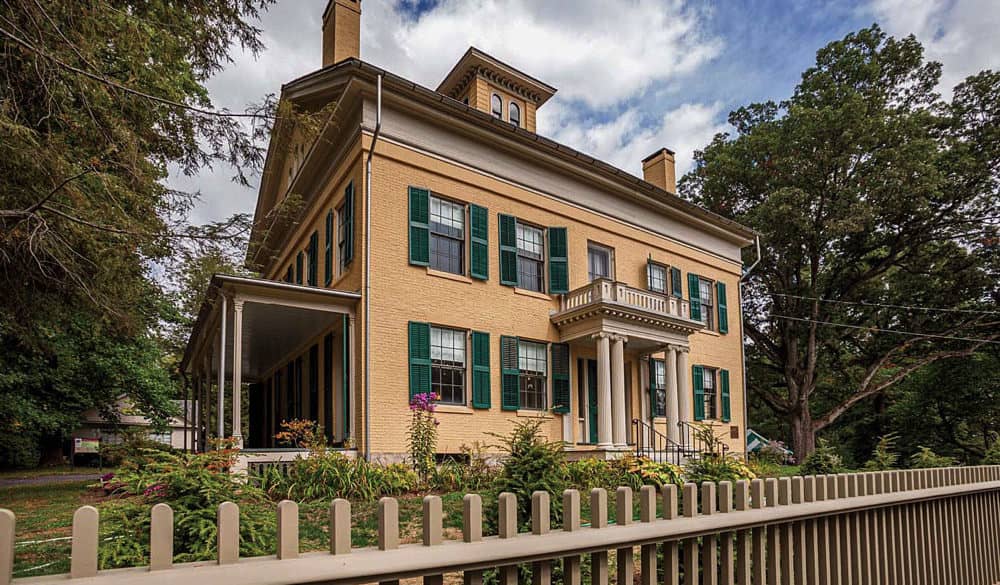10 Emily Dickinson Facts

1. Her family home is a museum
Samuel Dickinson, Emily Dickinson's grandfather, had the family home built in the 19th century. It was a large mansion in the center of Amherst that became the Dickinson family home for over a century before it was sold. In 1965 Amherst College bought the homestead. In 2003 it formally became the Emily Dickinson Museum along with the home next door that belonged to Emily's niece.
2. Her father was a United States Senator.
Emily Dickinson was born into a privileged life in Amherst, Massachusetts. Edward Dickinson was a well-regarded lawyer from the Whig party. After graduating from Yale and then the Northampton Law School he served as the treasurer of Amherst College. He served four non-consecutive terms on both the Massachusetts House of Representatives, the Massachusetts Senate, and the United States Congress.
3. Only ten of her poems were published during her lifetime.
Emily Dickinson kept the majority of her work to herself. Only after her death did her sister discover collections of poetry that Dickinson had compiled and refined during her lifetime. She shared her poetry during her life in written correspondence with friends, and occasionally asked for guidance from literary advisors such as Thomas Wentworth Higginson. Poems that were published during her lifetime were mainly done so anonymously or without her consent.
4. The Dickinson family were devout Calvinists.
The essence of evangelical Calvinism is that humans are born as sinners and must be saved with conversion. The poet never underwent a Calvinist conversion, but seems to have been significantly influenced by the tenants of the faith. While she was drawn to Protestant dogma and Transcendentalism Dickinson never stopped believing in the immortal soul.
5. Botany was a passion in her early years.
While at the Amherst Academy Dickinson's teachers recognized her talent for composition, but were also impressed with her assemblage of a large herbarium. Dickinson excelled in Latin and created a meticulous collection of of pressed plants that were identified by their accurate Latin names.
6. She was incredibly reclusive.
From an early age Emily Dickinson chose to restrict her social engagements. In her late twenties she chose to stay within her family home for the vast majority of the time instead of venturing out into the world around her. She rarely travelled and based her perceptions of her friends on their ability to write a letter back to her.
7. Several mysterious love affairs may have taken place.
Despite her reclusive lifestyle Dickinson is believed to have had some love affairs. These affairs appear to have been brief but extremely impactful. For example, Dickinson was once seen sitting on the lap of her father's friend Judge Otis Lord. Little more is known about the duration of their physical experiences together, but she carried on letter writing correspondence with him until his death many years later.
8. She had a strained relationship with both of her parents.
Dickinson chose never to move out of her family home, but it wasn't because she got along so well with her parents. She described her mother as cold and unloving. Later in her life when her mother fell ill Dickinson apparently did begin to feel more affection for her. She seemed more amicable with her father, but he was said to have been unsupportive of female scholars. This might explain why Dickinson chose never to reveal her large collection of poetry.
9. Her work was initially criticized for its unique take on grammar.
Dickinson truly invented a unique style with her poetry that disregarded many common literary rules. She experimented with capitalization and allowed sentences to run on. Her work was inspired by the rhythmic devices of religious psalms, but she commonly interspersed her own creative pauses within the stanzas. Despite her cavalier approach to grammar Dickinson's poems have gone on to become regarded as unique literary masterpieces.
10. She suffered from unspecified health problems.
Emily Dickinson's reclusive behavior makes it difficult to determine what exactly she suffered from. Historians have wondered if she might have had epilepsy like one of her nephews. She certainly was affected by depression and anxiety disorders which made her prefer to stay indoors and away from society. Later in her life Dickinson began to suffer from pain in her eyes and sensitivity to light. She died at just 55 due to a stroke.
